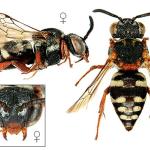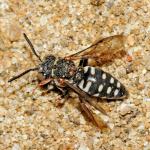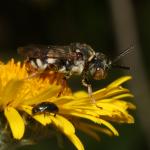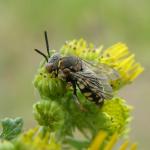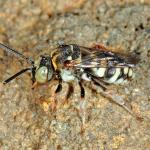Apis festiva CHRIST 1791; Apis pulchella CHRIST 1791; Apis notata CHRIST 1791; Apis muscaria CHRIST 1791; Epeolus pictus NYLANDER 1848; Apis murcaria CHRIST 1791 in FRIESE 1895; Epeolus productus THOMSON 1870
Throughout much of Britain and the Channel Islands, becoming scarce in northern England. There is a single confirmed record from the Isle of Man and one from south-west Scotland, but none from Ireland. Often locally common.
This species is not regarded as being scarce or threatened.
Open woodland, heathland, coastal dunes, cliffs and salt marshes (see range of hosts below).
Univoltine, June to late August, the form associating with Colletes halophilus flying from mid August to mid October.
A cleptoparasite of several Colletes species: C. daviesanus (Blair 1920; Carr 1916; Chambers 1949; Richards 1937, 1979), C. fodiens (Chambers 1949; Hallett 1928; Perkins 1920, 1924; Richards 1937, 1979), C. halophilus (Guichard 1974) and C. succinctus (Clark 1924; Butterfield & Fordham 1932; O’Toole & Raw 1991). However, there are very few rearing records and some of the above hosts have yet to be confirmed. The Scottish record from Torrs Warren, Wigtownshire (see map), was almost certainly attacking C. fodiens, though C. floralis was also present and in, apparently, greater numbers.
Bog pimperel (Anagallis tenella), bramble (Rubus fruticosus agg.), clover (Trifolium sp.), common fleabane (Pulicaria dysenterica), common ragwort (Senecio jacobaea), creeping buttercup (Ranunculus repens), creeping thistle (Cirsium arvense), hawkbit (Leontodon sp.), oxtongue (Picris sp.), thyme (Thymus sp.), viper’s-bugloss (Echium vulgare), and wild carrot (Daucus carota). It is most frequently seen on common ragwort (Senecio jacobaea).
No information available.
Profile written: 2002
Proofed: February 2012


